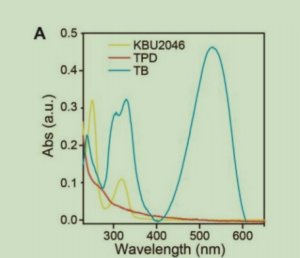文献:Cooperation therapy between anti-growth by photodynamic-AIEgens and anti-metastasis by small molecule inhibitors in ovarian cancer
文献链接:https://pubmed.ncbi.nlm.nih.gov/32104509/
作者:Jun Dai, Min Xu, Quan Wang , Juliang Yang , Jinjin Zhang , Pengfei Cui , Wenwen Wang , Xiaoding Lou, Fan Xia, Shixuan Wang
相关产品:
原文摘要:Metastasis is one of the main causes of death and treatment failure in ovarian cancer. Some small molecule inhibitors can effectively inhibit the metastasis of primary tumors. However, they do not kill the primary tumor cells, which may lead to continuous proliferation. Herein, we have prepared a multifunctional nanoparticles named TPD@TB/KBU2046, which consisted of three functional moieties: (1) KBU2046 (small molecule inhibitor) that can inhibit the metastasis of the primary tumors, (2) TB (photodynamic-AIEgens) that may suppress the growth of the primary tumors, and (3) TPD, which contains TMTP1 (a targeting peptide, which specifically binds to highly metastatic tumor cells) that can enhance the TB/KBU2046 dosage in the tumor site.
Methods: The TPD@TB/KBU2046 was prepared by nano-precipitation method. We linked the targeting peptide (TMTP1) to the nanoparticles via amidation reaction. TPD@TB/KBU2046 nanoparticles were characterized for encapsulation efficiency, particle size, absorption spectra,emission spectra and ROS production. The combinational efficacy in image-guided anti-metastasis and photodynamic therapy of TPD@TB/KBU2046 was explored both in vitro and in vivo.
Results: The TPD@TB/KBU2046 showed an average hydrodynamic size of approximately 50 nm with good stability. In vitro, TPD@TB/KBU2046 not only inhibited the metastasis of the tumors, but also suppressed the growth of the tumors under AIEgens-mediated photodynamic therapy. In vivo, we confirmed that TPD@TB/KBU2046 has the therapeutic effects of anti-tumor growth and anti-metastasis through subcutaneous and orthotopic ovarian tumor models.
Conclusion: Our findings provided an effective strategy to compensate for the congenital defects of some small molecule inhibitors and thus enhanced the therapeutic efficacy of ovarian cancer.
NHS-PEG-DSPE的具体结构为N-羟基琥珀酰亚胺(NHS)基团连接到聚乙二醇(PEG)上,PEG的另一端则连接到1,2-二硬脂酰-sn-甘油-3-磷酸乙醇胺(DSPE)上。这种结构使得NHS-PEG-DSPE兼具了NHS的活性、PEG的亲水性和DSPE的疏水性,从而赋予了它多种功能。TPD@TB/KBU2046的多功能纳米颗粒,由三个功能部分组成:(1)KBU2046(小分子抑制剂),可以抑制原发tumor的转移,(2)可以抑制原发tumor的TB(aiegens),抑制原发tumor的生长;(3) TPD,包含TMTP1(一种靶向肽,专门与高转移性tumor细胞结合),可以提高tumor部位TB/KBU2046的剂量。

图为:协同Treatment 对tumor有抗转移和抗生长的作用
NHS-PEG-DSPE在TMTP1-PEG-DSPE合成中的应用:
通过酰胺化反应将锡-甘油-3-琥珀酰亚胺(聚乙二醇)-2000](NHS-PEG-DSPE,PD)与TMTP1 (T)连接,得到TMTP1-PEG-DSPE(TPD)。简而言之,将NHS-PEG-DSPE加入到DMF溶液的TMTP1中。将上述溶液倒入超纯水中。然后,将反应产物加入到水溶液中,在流动的超纯水中通过透析纯化,冻干后得到产物TPD。
NHS-PEG-DSPE在TPD@TB/KBU2046纳米颗制备中的应用:
NHS-PEG-DSPE、TMTP1-PEG-DSPE、2、6-二(4-(二苯氨基)苯phenyl)-4,8-bis((2-ethylhexyl)oxy)benzo[1,2-b:4,5-b‘]d噻吩1、1、5、5-四氧化物和4’-氟黄酮同时溶解在四氢呋喃(THF)溶液中。用微尖探针超声仪将上述溶液搅拌,将混合溶液加入水中,然后用氮气将混合溶液中的有机溶剂THF吹干。然后通过滤膜过滤溶液,得到目标纳米颗粒。采用仪器检测粒径,在PBS缓冲液中测定粒径。

图为:TPD、TB和KBU2046的紫外-可见吸收光谱
结论:NHS-PEG-DSPE的NHS基团在特定的pH条件下能够与含有伯胺基团的分子(如抗体、肽等)发生反应,实现靶向分子的偶联。在TPD@TB/KBU2046纳米颗粒的制备中,利用NHS-PEG-DSPE的这一特性,将具有特定靶向性的分子(如TMTP1靶向肽)偶联到纳米颗粒表面,从而实现纳米颗粒的靶向递送。这种靶向递送能够提高化合物在tumor组织或其他部位的积累,减少对正常组织的损伤,提高效果。通过NHS-PEG-DSPE的修饰,还可以在TPD@TB/KBU2046纳米颗粒表面偶联多种功能分子,实现多模态成像。这些功能分子能够发出特定的信号,用于生物体内的成像。同时,它们还可以与化合物或其他分子结合,实现化合物的递送。

 2025-02-14 作者:lkr 来源:
2025-02-14 作者:lkr 来源:

